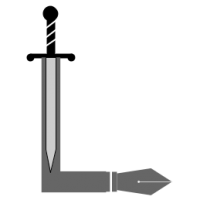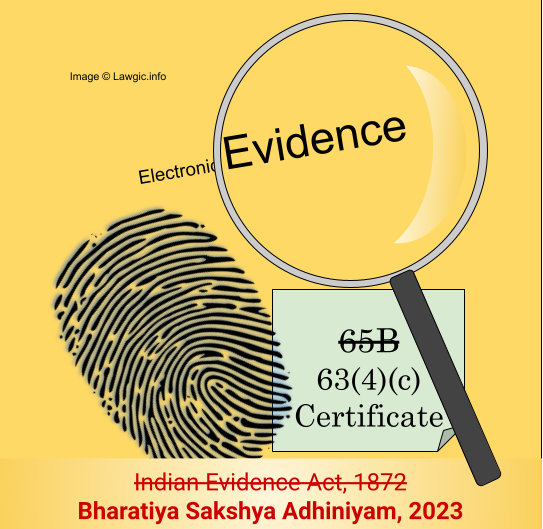Here’s a comparison of the old sections from the Indian Evidence Act, 1872, and the new sections of the BSA Bharatiya Sakshya Adhiniyam, 2023, focusing on electronic evidence:
| Aspect | Indian Evidence Act, 1872 | Bharatiya Sakshya Adhiniyam, 2023 | Differences |
|---|---|---|---|
| Definition of Document | Section 3: “‘Document’ means any matter expressed or described upon any substance by means of letters, figures or marks, or by more than one of those means, intended to be used, or which may be used, for the purpose of recording that matter.” | Section 2(d) “document” means any matter expressed or described or otherwise recorded upon any substance by means of letters, figures or marks or any other means or by more than one of those means, intended to be used, or which may be used, for the purpose of recording that matter and includes electronic and digital records. | Expands the definition to explicitly include electronic and digital records. |
| Admissions | Section 17: “An admission is a statement, oral or documentary or contained in electronic form, which suggests any inference as to any fact in issue or relevant fact…” | Section 15: “An admission is a statement, oral, documentary or contained in electronic form, which suggests any inference as to any fact in issue or relevant fact…” | No significant change. |
| Entries in Books of Account | Section 34: “Entries in books of account, including those maintained in an electronic form, regularly kept in the course of business, are relevant…” | Section 28: “Entries in books of account, including those maintained in electronic form, regularly kept in the course of business, are relevant…” | No significant change. |
| Relevancy of Entry in Public Record | Section 35: “An entry in any public or other official book, register or record, including electronic records kept in the performance of an official duty…” | Section 29: “An entry in any public or other official book, register or record, including electronic records kept in the performance of an official duty…” | No significant change. |
| Evidence to be Given When Statement Forms Part | Section 39: “When any statement of which evidence is given forms part of a longer statement, or of a conversation or part of an isolated document, or is contained in a document which forms part of a book, or is contained in part of an electronic record, evidence shall be given of so much and no more of the statement, conversation, document or electronic record as the Court considers necessary…” | Section 33: “What evidence to be given when statement forms part of a conversation, document, electronic record, book or series of letters or papers. – When any statement of which evidence is given forms part of a longer statement, or of a conversation or part of an isolated document, or is contained in a document which forms part of a book, or is contained in part of electronic record or of a connected series of letters or papers, evidence shall be given of so much and no more of the statement, conversation, document, electronic record, book or series of letters or papers as the Court considers necessary in that particular case to the full understanding of the nature and effect of the statement, and of the circumstances under which it was made.” | No significant change. |
| Opinions of Experts | Section 45: “When the Court has to form an opinion upon a point of foreign law, or of science, or art, or as to identity of handwriting or finger impressions, the opinions upon that point of persons specially skilled in such foreign law, science or art, or in questions as to identity of handwriting or finger impressions, are relevant facts.” | Section 39: Opinions of experts.—(1) When the Court has to form an opinion upon a point of foreign law or of science or art, or any other field, or as to identity of handwriting or finger impressions, the opinions upon that point of persons specially skilled in such foreign law, science or art, or any other field, or in questions as to identity of handwriting or finger impressions are relevant facts and such persons are called experts. | No significant change. |
| Opinion as to Handwriting and Digital Signature | Section 47A: “When the Court has to form an opinion as to the digital signature of any person, the opinion of the Certifying Authority which has issued the Digital Signature Certificate is a relevant fact.” | Section 41: “When the Court has to form an opinion as to the digital signature of any person, the opinion of the Certifying Authority which has issued the Digital Signature Certificate is a relevant fact.” | No significant change. |
| Primary Evidence | Section 62: “Primary evidence means the document itself produced for the inspection of the Court.” | Section 57: “Primary evidence. – Primary evidence means the document itself produced for the inspection of the Court. Explanation 4. – Where an electronic or digital record is created or stored, and such storage occurs simultaneously or sequentially in multiple files, each such file is primary evidence. Explanation 5. – Where an electronic or digital record is produced from proper custody, such electronic and digital record is primary evidence unless it is disputed. Explanation 6. – Where a video recording is simultaneously stored in electronic form and transmitted or broadcast or transferred to another, each of the stored recordings is primary evidence. Explanation 7. – Where an electronic or digital record is stored in multiple storage spaces in a computer resource, each such automated storage, including temporary files, is primary evidence. | Adds detailed explanations to clarify what constitutes primary evidence for electronic records. |
| Proof of Documents by Primary Evidence | Section 64: “Documents must be proved by primary evidence except in the cases hereinafter mentioned.” | Section 59: “Documents must be proved by primary evidence except in the cases hereinafter mentioned.” | No significant change. |
| Admissibility of Electronic or Digital Record | Section 65B: “Notwithstanding anything contained in this Act, any information contained in an electronic record which is printed on a paper, stored, recorded or copied in optical or magnetic media produced by a computer shall be deemed to be also a document, if the conditions mentioned in this section are satisfied.” | Section 63: Admissibility of electronic records.—(1) Notwithstanding anything contained in this Adhiniyam, any information contained in an electronic record which is printed on paper, stored, recorded or copied in optical or magnetic media or semiconductor memory which is produced by a computer or any communication device or otherwise stored, recorded or copied in any electronic form (hereinafter referred to as the computer output) shall be deemed to be also a document, if the conditions mentioned in this section are satisfied in relation to the information and computer in question and shall be admissible in any proceedings, without further proof or production of the original, as evidence or any contents of the original or of any fact stated therein of which direct evidence would be admissible. | Broadens scope to include records created or stored in communication devices. |
| Rules as to Notice to Produce | Section 66: “Secondary evidence of the contents of the documents referred to in section 65, clause (a), shall not be given unless the party proposing to give such secondary evidence has previously given to the party in whose possession or power the document is, such notice to produce it as is prescribed by law…” | Section 64: “Secondary evidence of the contents of the documents referred to in section 65, clause (a), shall not be given unless the party proposing to give such secondary evidence has previously given to the party in whose possession or power the document is, such notice to produce it as is prescribed by law…” | No significant change. |
| Proof as to Electronic Signature | Section 67A: “Except in the case of a secure electronic signature, if the electronic signature of any subscriber is alleged to have been affixed to an electronic record, the fact that such electronic signature is the electronic signature of the subscriber must be proved.” | Section 66: “Except in the case of a secure electronic signature, if the electronic signature of any subscriber is alleged to have been affixed to an electronic record, the fact that such electronic signature is the electronic signature of the subscriber must be proved.” | No significant change. |
| Presumption as to Gazettes in Electronic Form | Section 81A: “The Court shall presume the genuineness of every electronic record purporting to be the Official Gazette, or purporting to be an electronic record directed by any law to be kept by any person, if such record is kept substantially in the form required by law and is produced from proper custody.” | Section 81A: “The Court shall presume the genuineness of every electronic record purporting to be the Official Gazette, or purporting to be an electronic record directed by any law to be kept by any person, if such record is kept substantially in the form required by law and is produced from proper custody.” | No significant change. |
| Presumption as to Electronic Agreements | Section 85A: “The Court shall presume, unless contrary is proved, that every electronic record purporting to be an agreement containing the electronic signature of the parties was so concluded by affixing the electronic signature of the parties.” | Section 85: “Presumption as to electronic agreements.—The Court shall presume that every electronic record purporting to be an agreement containing the electronic or digital signature of the parties was so concluded by affixing the electronic or digital signature of the parties.” | No significant change. |
| Presumption as to Electronic Records and Signatures | Section 85B: “Unless the contrary is proved, the Court shall presume that the secure electronic signature is affixed by the subscriber with the intention of signing or approving the electronic record.” | Section 86: “Presumption as to electronic records and electronic signatures. (1) In any proceeding involving a secure electronic record, the Court shall presume unless contrary is proved, that the secure electronic record has not been altered since the specific point of time to which the secure status relates. (2) In any proceeding, involving secure electronic signature, the Court shall presume unless the contrary is proved that— (a) the secure electronic signature is affixed by subscriber with the intention of signing or approving the electronic record; (b) except in the case of a secure electronic record or a secure electronic signature, nothing in this section shall create any presumption, relating to authenticity and integrity of the electronic record or any electronic signature.” | No significant change. |
| Presumption as to Electronic Messages | Section 88A: “The Court may presume that an electronic message forwarded by the originator through an electronic mail server to the addressee to whom the message purports to be addressed corresponds with the message as fed into his computer for transmission; but the Court shall not make any presumption as to the person by whom such message was sent.” | Section 90: “Presumption as to electronic messages.—The Court may presume that an electronic message, forwarded by the originator through an electronic mail server to the addressee to whom the message purports to be addressed corresponds with the message as fed into his computer for transmission; but the Court shall not make any presumption as to the person by whom such message was sent.” |
Is this Electronic Evidence Certificate under section 63(4)(c) of BSA required for Primary or Secondary Evidence?
From the bare reading of the Act, there is now no difference between an Original Electronic record and its copy. Therefore now there is no distinction between an original electronic record as Primary Evidence and its reproduction as Secondary Evidence (supported by a certificate). This means that there is a rebuttable presumption that even a copy of an electronic file, Video, Phone recording, Digital Image, Audio File, emails, server logs, documents on computers, laptop or smartphone, messages, websites, locational evidence and voice mail messages, is as good as its original.
As this is still a very grey area and is contrary to the plethora of precedents in the matter, there is still scope for it being further clarified and amended and we must wait and watch. Till then it appears that the legislature intended that there be no difference between Primary and Secondary Evidence, as the definition of Secondary Evidence does not contain any reference to Electronic Records.
Section 57: Primary evidence. – Primary evidence means the document itself produced for the inspection of the Court.
Explanation 4. – Where an electronic or digital record is created or stored, and such storage occurs simultaneously or sequentially in multiple files, each such file is primary evidence.
Explanation 5. – Where an electronic or digital record is produced from proper custody, such electronic and digital record is primary evidence unless it is disputed.
Explanation 6. – Where a video recording is simultaneously stored in electronic form and transmitted or broadcast or transferred to another, each of the stored recordings is primary evidence.
Explanation 7. – Where an electronic or digital record is stored in multiple storage spaces in a computer resource, each such automated storage, including temporary files, is primary evidence.
Is there a format for the Certificate to be submitted with electronic evidence?
The old 65B Certificate under Indian Evidence Act is now replaced by a certificate under the provisions of section 63(4)(c) of the Bharatiya Sakshya Adhiniyam 2023 which is in 2 parts, PART A and PART B.
Part A is to be filled by the Party submitting the evidence.
Part B is to be filled by the Expert (as per Section 39)
(2) When in a proceeding, the court has to form an opinion on any matter relating to any information transmitted or stored in any computer resource or any other electronic or digital form, the opinion of the Examiner of Electronic Evidence referred to in section 79A of the Information Technology Act, 2000 (21 of 2000), is a relevant fact.
Explanation.- For the purposes of this sub-section, an Examiner of Electronic Evidence shall be an expert.

Download a PDF sample format of the BSA 63 (4) (c) Certificate here.
Is a report regarding the Hash Value of an electronic record mandatory?
Yes. In the new Act, a report of the hash value of the electronic record is required to be submitted along with the certificate under section 63(4)(c) of the Bharatiya Sakshya Adhiniyam 2023. Although a format of the hash report is not enclosed you can refer to this article on How to obtain the hash value of an electronic record for submission in the court.


1 thought on “Electronic Evidence under the BSA Bharatiya Sakshya Adhiniyam, 2023 – Replacement for Section 65B of the Indian Evidence Act.”